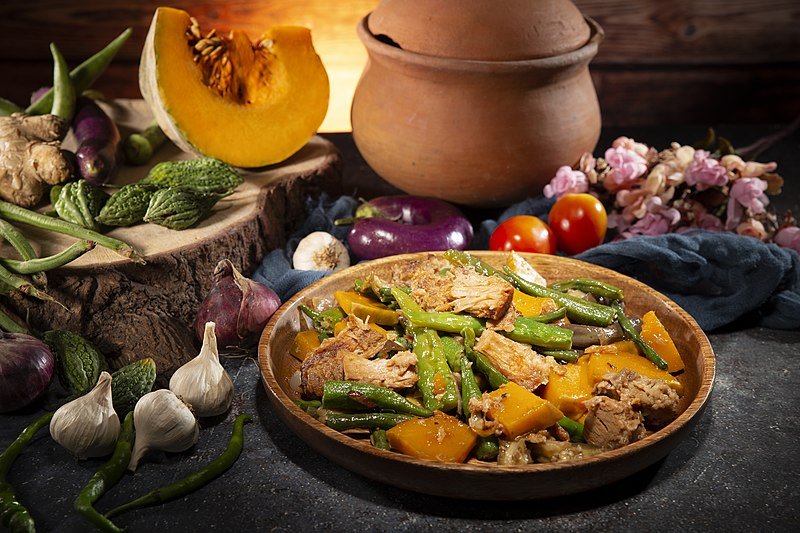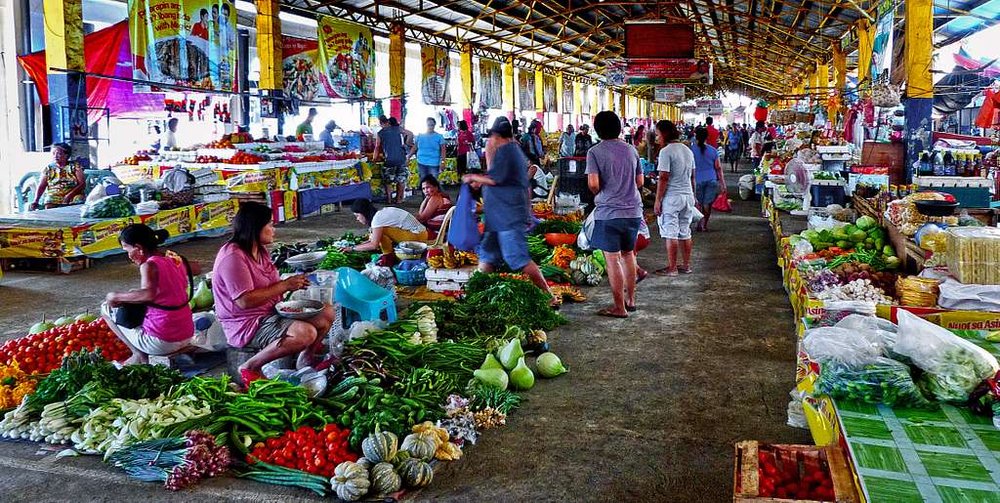The Comforting Squidginess of Slow-Cooked Veggies
Second Prize winner of the 2022 Doreen Gamboa Fernandez Food Writing Award

Pinakbet (Source: Wikipedia | Photo by Jesse Alegre)
The first thought was about a Provençal classic — ratatouille — that a friend and I had at a restaurant outside Manila whose owner was a reputed exponent of French cuisine. We had so anticipated our favorite, but when it came, it was unrecognizable. To be kind, I called it an Asian variant. Stir-fried, not braised. Certainly, the vegetables had been exposed to heat, but neither hot enough nor long enough to transform the eggplant’s astringency nor the bell peppers’ acridity. Not even long enough for the tomatoes to exude their juices. Ah… but the plating? Faultless! The purples, reds, and greens appetizingly glossy. Our eyes definitely had their fill, but ratatouille as we’d known it — and loved it — it was not.
Philippine-received wisdom for cooking veggies is akin to that for pasta: al dente. Local greens from pechay to Chinese cabbage; sugar pea shoots and pods; string beans; and kangkong are at their best, aesthetically and organoleptically, when their color is vibrant, their texture crunchy. It is quite understandable if some cooks — from inexperience, a desire for innovation, or an evangelical zeal for retaining phytonutrients— opt to stir-fry what in its Mediterranean home is cooked slowly and patiently. Braising, simmering, or baking elevates the eggplant from lowly to sublime; time is as vital an ingredient to a ratatouille as its accompanying ingredients to result in that archetypal sensuous consistency. Manifest in the term ratatouille itself, as in similar time-intensive vegetable dishes like Mallorcan tumbet, Italian caponata, Romanian ghiveci (pronounced “giv-etch”) are onomatopoeic syllables that convey —to me at least— a comforting squidginess.
That same yielding consistency is characteristic of the iconic Ilocano comfort food, pinakbet, often called the Philippine ratatouille. Long simmering renders its contents so extraordinarily tender, that to stir pinakbet is considered a solecism. One tosses the closed pan or clay pot, as similarly advised for ratatouille: touiller also means “to toss.” Hence the photograph of pinakbet, its ingredients well-formed rather than shrunken (kebbet) as expected, made me question its provenance. Basic pinakbet comprises the trifecta of bitter melon, eggplant, and tomatoes. Preferred are the small, dark-green, intensely bitter paria ti bakir (wild bitter melon). Similarly preferred are small eggplants; both often left whole to avoid disintegration during their long cooking. The proportion of tomatoes to other ingredients is crucial. I once copied the sumptuously tomato-rich pinakbet variant of an aunt, and a cousin declared it “not pinakbet.” Ginger (lots!), garlic cloves, shallots or onions, and bagoong (bugguong in Ilocano, fermented fish) provide the requisite flavors and aroma. I am reluctant to use “fish paste” to translate anchovy-based bugguong munamon or baby oyster-based bugguong tirem, whose consistency is more of preserved marine flesh suspended in thick briny broth. Ilocanos scoff at shrimp-based alamang. Other ingredients may be okra, parda (Dolichos lablab pods), or winged beans (pallang). But besides okra and squash (the latter inauthentic[i], apparently), I’ve never added these myself nor eaten them in any pinakbet cooked by friends or relatives.

Vegetables in the Batac City Market, Philippines (Photo by Bernard Spragg/Picryl)
Some Ilocanos avow that authentic pinakbet is purely vegetarian. However, meat in the form of sitcharon (as bagnet is called in my family’s southern Ilocos hometown) or pork belly slices, whose fat is rendered to sauté the aromatics, is highly welcomed. Sitcharon, especially so, as it becomes meltingly tender, its unctuousness contributing to pinakbet’s soothing mouthfeel. Some add fried or grilled fish, but I’ve never seen it in my family’s pinakbet.
So how do we distinguish authentic from inauthentic? Who arbitrates authenticity? Is “authenticity” even valid in this age of gastronomic globalization and widespread cultural appropriation? The Provençal food writer Mireille Johnston[ii] wrote that “some cooks strongly feel that the vegetables in a ratatouille should be pureed.” Larousse Gastronomique[iii] notes that “purists insist on the vegetables cooked separately, then … cooked together until smooth and creamy.” Johnston herself fried each vegetable separately between 5 - 10 minutes, then simmered them for one hour.
I would not cavil about the authenticity of ingredients or methods. Whether one includes sweet potato, or squash, or alamang, or pre-sautés the aromatics in pinakbet. Whether to cook the vegetables together, and not to pre-fry them separately, in ratatouille, tumbet, ghiveci, or caponata. What matters to me, and all who adore this pan-universal genre of slow- and lovingly cooked vegetable dishes, is their meltingly soft consistency. I doubt aficionados would welcome a crisply stir-fried ratatouille or tumbet or ghiveci or caponata. Nor I, a crunchy pinakbet.
As a child, I used to turn my nose up at pinakbet. Now, over half a century later and thousands of miles far from home, whenever I feel out of sorts, I take comfort in that endearingly squidgy melange of salty, sour, bitter, sweet umaminess.
[i] Pinakbet Ingredients. 5/25/2012. http://pinakbetrepublic.blogspot.com. Accessed 11/1/2022. “These are the basic ingredients of an authentic Ilokano pinakbet. …reduced to only paria, tarong, kamatis in some cases…. And please, please, no karabasa (squash fruit), because a real Ilokano pinakbet has no karabasa in it but only in a Tagalog pakbet….”
[ii] Johnston, Mireille. 1976. The Cuisine of the Sun: Classic Recipes from Nice and Provence. New York: Random House:
[iii] Larousse Gastronomique. 2001. London: Octopus Publishing Group, Ltd.

Jeanne Jakob-Ashkenazi has won the DGF Award for her essays two times before. She is based in Valencia, Spain where she researches and writes on food history.







No comments:
Post a Comment